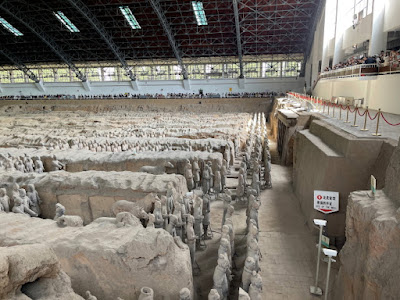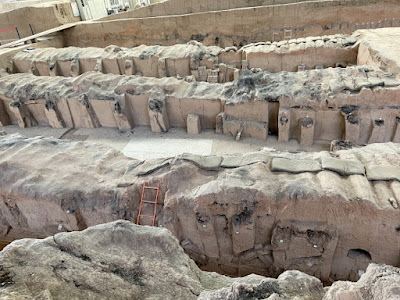Since it was about 56 km (35 miles) from our hotel in Xi'An, China, to Emperor Qin Shi Huang's Terracotta Army, we hired a guide and car to drive us to the site. Our guide's English name was "Nancy."
Nancy was happy to see us and said she really enjoys her job because she gets to meet tourist from around the world.
After entering through a controlled entrance gate, it was a short hike to a large building that covers the area known as Pit 1. A sign above the entrance door is written in "Old Chinese," which Nancy said is more difficult to read and write than the current Chinese characters.
 |
| Picture by Heather |
 |
| Picture by Heather |
 |
| Picture by Kolohe |
The Terracotta Army was not discovered until 1974, when a farmer digging a well found part of a terracotta soldier buried deep in the ground. Archeologists could not determine what he had discovered because there were no historical writings that described anything that would have been buried in that location. The archeologist said that every known historical site in China was well documented; so if it was something important, it would have been discussed in the historic writings.
After doing some research and additional excavations, it was determined that the Terracotta Army discovery was part of Qin Emperor's tomb that was located 1.5 km (0.93 miles) to the east. Everyone was very surprised because Qin Emperor's Terracotta Army was never recorded anywhere that could be found. Qin Shi Huang was the first emperor of China and the figures are now known to be a form of funerary art that was built to protect the emperor in his afterlife. The figures date from the late 200s BCE.
Ground-penetrating radar has now been used and it is believed that the Terracotta Army is just part of a much larger necropolis that covers 98 square kilometers (38 square miles). It is estimated that in the three main pits there are 8,000 soldiers, 130 chariots with 520 horses, and 150 cavalry horses. In other pits being excavated they have found acrobats, strongmen, officials, musicians, stone armor suits, burial sites of horses, rare animals, and bronze cranes and ducks that had been set in an underground park.
Pit 1 is the most extensive of the three pits and contains eleven parallel rows of terracotta figures. Each row is 230 meters (750 ft) long, 3 meters (10 ft) wide, and vary in depth from 4.5 meters (15 ft) to 7 meters (23 ft). Within Pit 1 there are approximately 3,000 terracotta figures.
Visitors enter the Pit 1 building from the east side and travel around the pit in a clockwise direction.
 |
| Picture by Heather |
 |
| Picture by Heather |
 |
| Picture by Heather |
 |
| Picture by Kolohe |
 |
| Picture by Kolohe |
 |
| Picture by Kolohe |
 |
| Picture by Kolohe |
 |
| Picture by Kolohe |
 |
| Picture by Kolohe |
 |
| Picture by Kolohe |
 |
| Picture by Kolohe |
 |
| Picture by Kolohe |
 |
| Picture by Kolohe |

At the western end of the pit there is a "hospital" where the broken figures are put back together and refurbished. All of the soldiers are life-sized, ranging in size from 175 cm (5.74 feet) to about 200 cm (6.6 feet). Archeologists have yet to find a complete figure that is not broken, or any two figures that are alike. The figures were originally painted, but much of the color coating flakes off in less than four minutes after removing the mud surrounding the figures.
Archeologists believe that the terracotta figures were made using an assembly line process with the heads, arms, legs, and torsos created separately and then assembled by luting the pieces together. To ensure tight quality control, each workshop was required to inscribe its name on each item produced. This numbering has helped archeologists when reassembling the broken pieces.
The figures produced have been identified as "armored infantry; unarmored infantry, cavalrymen who wear a pillbox hat; helmeted drivers of chariots with more armor protection, spear-carrying charioteers; kneeling crossbowmen or archers who are armored; standing archers; and generals and other lower-ranking officers. There are, however, many variations in the uniforms within the ranks: for example, some may wear shin pads while other not; they may wear either long or short trousers, some of which may be padded; and their body armors vary depending on rank, function, and position in formation."
Apparently, after the Emperor's death, grave robbers removed all of the weapons and broke many figures. Other figures were broken when a roof covering the figures collapsed.
 |
| Picture by Kolohe |
 |
| Picture by Kolohe |
 |
| Picture by Kolohe |
 |
| Picture by Kolohe |
 |
| Picture by Kolohe |
 |
| Picture by Kolohe |
 |
| Picture by Kolohe |
 |
| Picture by Kolohe |
 |
| Picture by Kolohe |
There is even a veterinarian clinic to take care of broken horses.
 |
| Picture by Kolohe |
 |
| Picture by Kolohe |
After the figures have been sufficiently repaired to stand in a vertical position, they are placed in various pit areas to be finished with heads and other missing body parts. After the figures are fully repaired, they are moved to an area to wait for placement in one of the pit rows.
 |
| Picture by Kolohe |
 |
| Picture by Kolohe |
 |
| Picture by Kolohe |
 |
| Picture by Kolohe |
 |
| Picture by Heather |
 |
| Picture by Kolohe |
 |
| Picture by Heather |
 |
| Picture by Kolohe |
 |
| Picture by Kolohe |
 |
| Picture by Kolohe |
The best viewing area is on the north side of the pit because it is not as deep and visitors can get closer to the figures.
 |
| Picture by Heather |
 |
| Picture by Kolohe |
 |
| Picture by Heather |
 |
| Picture by Kolohe |
 |
| Picture by Kolohe |
 |
| Picture by Kolohe |
 |
| Picture by Kolohe |
Excavation work is still ongoing at the northeast part of Pit 1.
 |
| Picture by Kolohe |
 |
| Picture by Kolohe |
 |
| Picture by Heather |
In a different building, the areas being excavated appeared to be deeper than the Pit 1 depths.
 |
| Picture by Heather |
 |
| Picture by Heather |
 |
| Picture by Kolohe |
 |
| Picture by Kolohe |
 |
| Picture by Heather |
 |
| Picture by Kolohe |
 |
| Picture by Kolohe |
 |
| Picture by Kolohe |
In a different part of the building, a number of terracotta figures are enclosed in glass cases so visitors can get a really closeup view of the detail found in the figures.
 |
| Picture by Kolohe |
 |
| Picture by Kolohe |
 |
| Picture by Kolohe |
 |
| Picture by Kolohe |
 |
| Picture by Heather |
 |
| Picture by Kolohe |
 |
| Picture by Kolohe |
 |
| Picture by Kolohe |
 |
| Picture by Heather |
 |
| Picture by Kolohe |
 |
| Picture by Kolohe |
The museum's basement contained bronze cranes and ducks that were found at the site.
 |
| Picture by Heather |
 |
| Picture by Heather |
 |
| Picture by Heather |
The Terracotta Army has been featured in many magazines, including National Geographic. There were also other publications that described how the figures were originally painted.
 |
| Picture by Heather |
 |
| Picture by Heather |
 |
| Picture by Heather |
 |
| Picture by Heather |
On display outside of the building were some examples of what the Terracotta Army may have originally looked like when painted.
There were a number of other building on the site that featured all types of food and tourist souvenirs. One our favorites was a gem and mineral shop where we helped the Chinese economy. Since Linda was not able to go on this trip, we found a rare pink jade necklace for her.
 |
| Picture by Kolohe |
 |
| Picture by Kolohe |
 |
| Picture by Kolohe |

































































































No comments:
Post a Comment